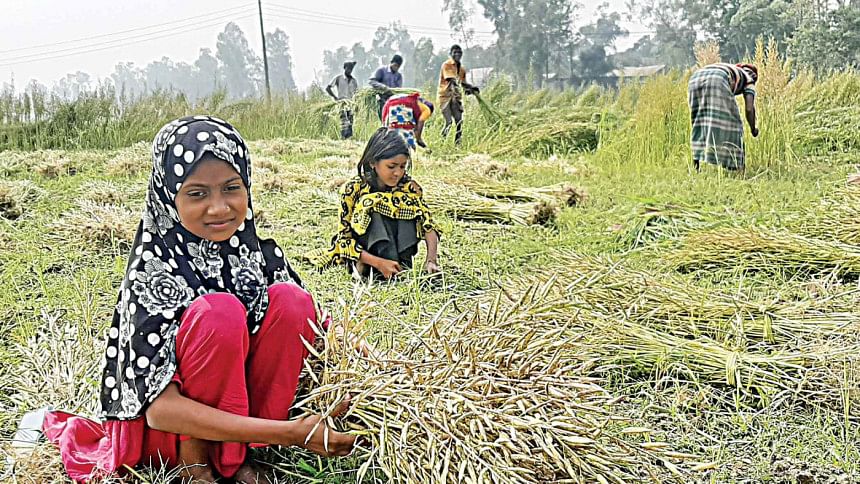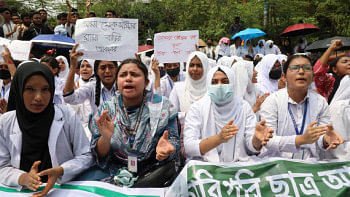Tangail farmers enjoy bumper mustard yield, better prices

Tangail is in for a bumper mustard yield this year due to favourable weather conditions. Farmers are also very happy being offered better prices in local markets.
They took on cultivating the cash crop just after facing devastating and prolonged floods. Support from the Department of Agricultural Extension (DAE) was at hand.
Farmers cultivated mustard alongside vegetables in the period between the harvest of Aman paddy and the planting of Boro.
DAE officials said farmers were more into cultivating mustard this year as floods had prevented many from growing Aman.
Nationally, farmers have sown mustard on 5.83 lakh hectares in the current marketing year ending in June, up 3 per cent from that the previous year, DAE data showed.
Though the acreage of mustard has declined over the past decade, the production of the oilseed soared thanks to the introduction of high-yielding varieties.
"Farmers are cultivating more high-yielding varieties of mustard in place of local varieties," said DAE Director General Md Asadullah.
Yields of improved mustard varieties can reach more than one tonne per hectare, whereas local varieties produce less than one tonne, he said.
Mustard production soared 27 per cent to 3.12 lakh tonnes in fiscal 2018-19, from 2.46 lakh tonnes in fiscal 2010-11, according to data from the Bangladesh Bureau of Statistics (BBS).
Tangail is one of the country's biggest zones for mustard cultivation, producing near about 50,000 tonnes a year.
Some 45,660 hectares of land were used: 24,445 hectares for the local variety and 21,215 hectares for hybrid ones.
In comparison, 41,700 hectares were used last year, meaning an increase of more than 4,000 hectares.
Farmer Nobiullah Mondol of Musduddi Uttorpara village in Dhanbari upazila cultivated BARI-14 and BARI-17 varieties on his three bighas of land.
He says mustard harvests come within just two months of sowing the seeds, and Boro paddy grows better on land from which mustard has just been harvested.
Mohammad Mahbubur Rahman, Dhanbari upazila agriculture officer, said this practice also reduced the cost for cultivating Boro paddy as farmers could make more profit having to use less fertiliser.
Necessary seeds and fertiliser were provided as incentives to 160 local farmers, while advice provided to all over the right use of fertiliser and pesticide, he said.
Farmers said production cost per bigha amounted to around Tk 3,000 to Tk 3,500, and a good yield equals about six to seven maunds.
Farmer Mortuz Ali of Jadavpur village in Sakhipur upazila cultivated eight bighas and got around 50 maunds.
"I have spent Tk 3,500, including for seeds, fertiliser and ploughing, behind each bigha. I hope to make a profit of Tk 6,000 to Tk 7,000 from each bigha," he said.
Selling his mustard at Nakshala market in Sakhipur, farmer Abu Sayeed said to have secured better prices.
"I am happy to get Tk 1,700 and Tk 1,800 per maund, which was Tk 1,400 to Tk 1,600 last year," he said.
Mustard trader Abdul Mannan said higher prices were prevailing, and he was offering Tk 1,700 to Tk 2,000 for each maund.
Agriculturist Ahsanul Bashar, deputy director of the Tangail DAE office, told The Daily Star that mustard cultivation in the district was increasing every year as interest was being sparked by repeated bumper production and increasing prices.
"After the devastating and prolonged floods, we have provided the necessary seeds and fertiliser to the farmers as incentives. A total of 34,000 local farmers got government support," he said.
A large number of local farmers cultivated the BARI-14 variety this year, and the seeds were made available to dealers of the Bangladesh Agriculture Development Corporation, he said.
Local varieties can yield one tonne per hectare, whereas the BARI-14 almost double, he added.

 For all latest news, follow The Daily Star's Google News channel.
For all latest news, follow The Daily Star's Google News channel. 



Comments